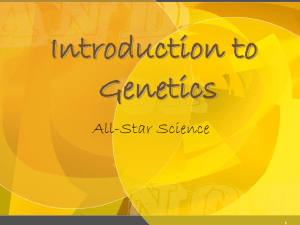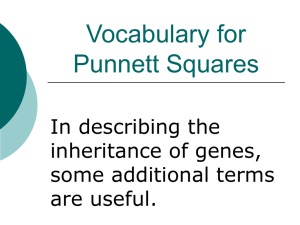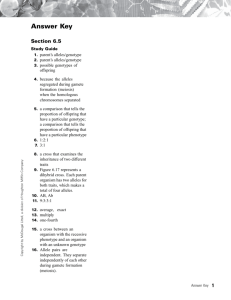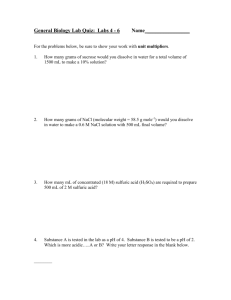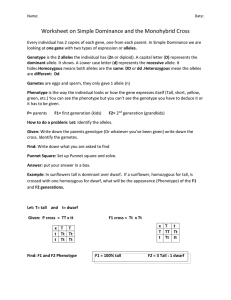Basic Genetics
advertisement
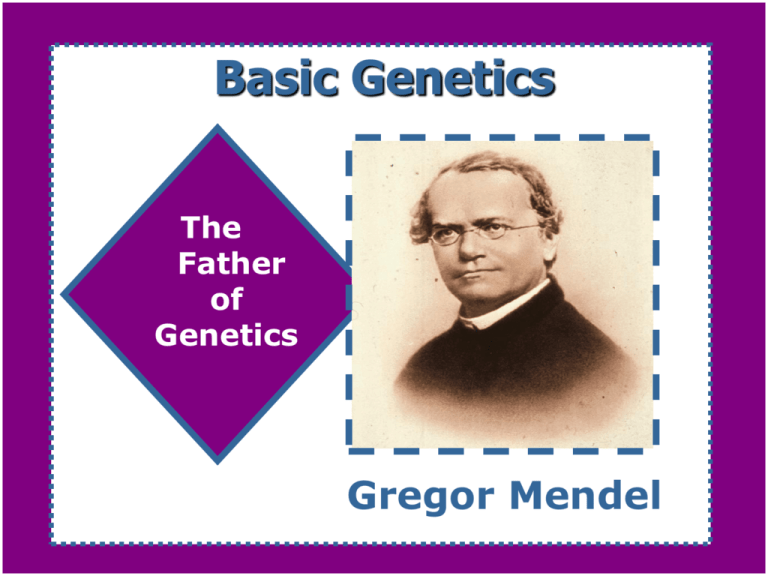
Basic Genetics The Father of Genetics Gregor Mendel Gregor Mendel Objectives: To distinguish between heredity and inheritance To define pollination To identify the major parts of a flowering plant To describe Mendel’s experiments in heredity Heredity – transmission of traits from parents to their offspring Inheritance passing of traits by heredity Mendel’s experiments used pea plants Pollination – transfer of pollen from anthers to stigma in flowers 1) self pollination occurs within the same flower or same plant 2) cross pollination occurs between different plants Receptical Mendel’s Crosses with Pea Plants P parental 1 generation Pure tall plants X Cross F1 F2 first filial generation Pollination All Tall plants Self second filial generation Pure short plants Pollination 787 tall plants, 277 short plants 3 to 1 ratio Objective: To describe Mendel’s 3 principles of inheritance 1) Principle of Dominance and Recessiveness Each trait is controlled by 2 factors, one factor (dominant ) may mask the other factor (recessive ) preventing it from having an effect. P1 F1 F2 2) Principle of Segregation The two factors for a characteristic separate during the formation of eggs and sperm. 3) Principle of Independent Assortment Factors for different characteristics are distributed to reproductive cells independently. Objectives: To define gene To define allele Gene – segment of DNA on a chromosome that codes for a particular protein genes occur in pairs Allele – alternative form of a gene T = tall t = short Recessive Lowercase letter Dominant capital letter G = green pods g = yellow pods Objectives: To define genotype and phenotype To distinguish between homozygous and heterozygous To define multiple alleles Genotype – genetic makeup of an organism (genes) (internal information) Phenotype – physical characteristics of an organism (external appearance) What does Phenotypes come form Example of Genotype and Phenotype TT genotype Tall phenotype Homozygous – when both alleles of a pair are the same homozygous dominant homozygous recessive TT tt Heterozygous – when both alleles of a pair are not the same heterozygous (tall) Tt Multiple alleles – 3 or more alleles that control a trait Example – blood type (IA,IB,io) GENOTYPES IA IA IAio IB IB IBio IAIB ioio RESULTING PHENOTYPES Type A Type A Type Type Type Type B B AB O Objectives: To define probability To predict the results of monohybrid crosses by using a Punnett square Probability – likelihood that a particular event will occur number of times a particular event occurs Probability = number of opportunities for the event to occur Example 1: Flipping a Coin Chances of coming up heads = ½ Example 2: Rolling Dice 1 6 probability of rolling a six on 1 dice x 1 6 probability of rolling a six on 1 dice = 1 36 probability of rolling a six on 2 dice monohybrid cross – Objectives: To define test cross To define incomplete dominance To define codominance Test cross – an individual with unknown genotype is crossed with a homozygous recessive individual used to determine the genotype of any individual whose phenotype is dominant In rabbits, black fur color is dominant over brown fur color B = black fur b = brown fur bb BB or Bb Incomplete Dominance when 2 or more alleles influence the phenotype results in a trait intermediate between the dominant and recessive traits Incomplete Dominance Codominance – condition in which both alleles of a gene are expressed example – roan coat in horses white hair (HW) is codominant with red hair (HR) horses with genotype (HRHW) have coats with a mixture of red and white hairs (roan) Roan Coat Objectives: To predict the results of dihybrid crosses by using a Punnett square dihybrid cross – cross between individuals that involves two pair of contrasting traits


